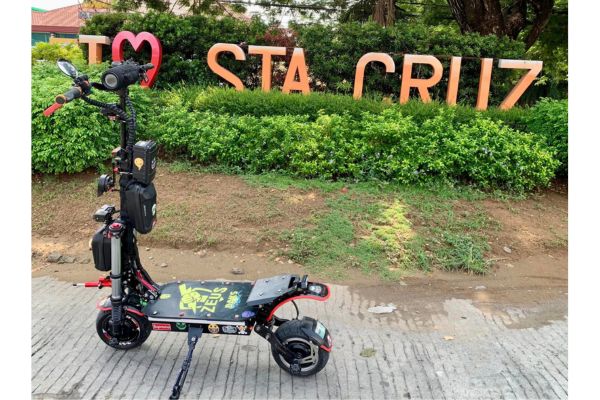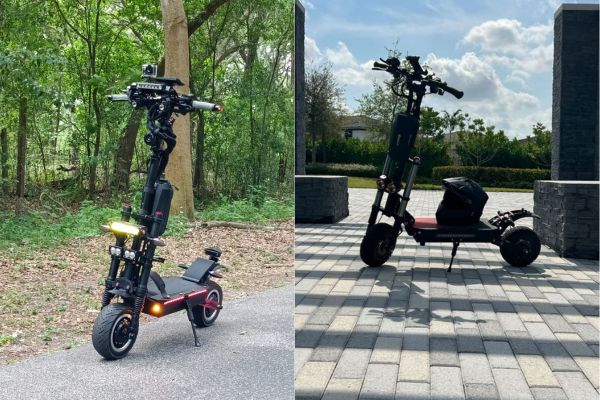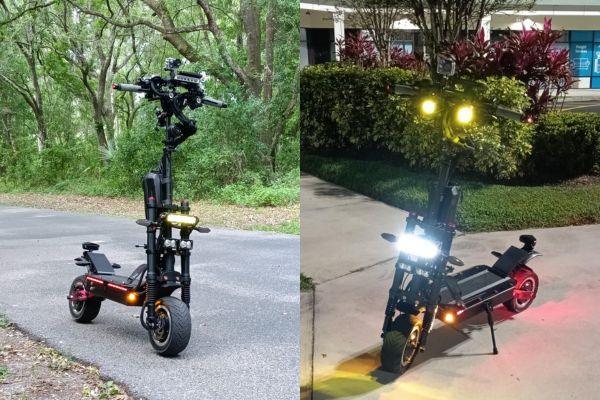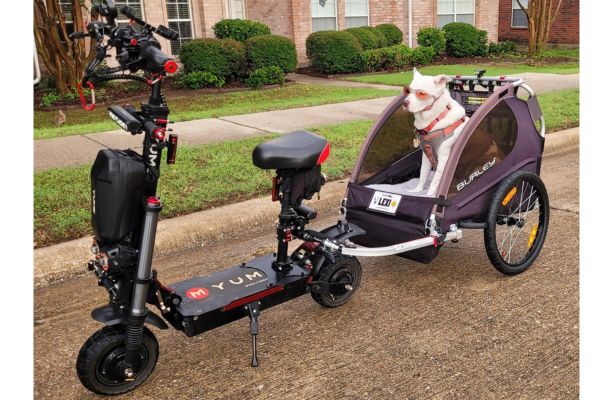The YUME Y11+ positions itself in the budget hyper‑scooter segment, offering striking performance numbers, up to 6000W peak power, and around 50 mph top speed, at a price far lower than many of its competitors. However, this attractive cost comes with considerable long-term risk.
Our research uncovered inconsistencies in crucial product details across vendors, such as battery capacity and weight, suggesting uneven quality control and a “parts‑bin” build process. Reviews from both users and experts describe a thrilling ride but raise concerns about reliability, construction, and the expectation of hands‑on maintenance.
The most serious issues appear after purchase. The scooter’s warranty is limited, especially for the battery and motor, and its international validity is often unclear, potentially leaving owners to pay for shipping or repairs themselves. There is also no large service network authorized by YUME, meaning that the owner must often act as their own mechanic.
So, our overall conclusion: the YUME Y11+ is conditionally recommended, but only for a very specific kind of buyer, a mechanically skilled enthusiast who can handle high risk, perform repairs themselves, and values raw performance over reliability. For buyers who want dependable support and durability, other models would be much wiser. The YUME Y11+ is better suited as a performance project than as a ready-to-go transportation appliance.
Yume Y11+ Plus Electric Scooter

The Yume 11 is one of the greatest electric scooters for those seeking comfort, power, and speed. It has a robust suspension system, two motors, and hydraulic brakes, among many other characteristics. The Y11 manages any situation with ease.
Whether you are riding on tough terrain or city streets. It is more fun to use and has a longer battery life with additional features like the Yume app and LED lights.
The advantages greatly outweigh the disadvantages. Even though it could be heavy and take longer to charge with a regular charger. The Yume Y11 is unquestionably a scooter to take into consideration if you’re searching for a high-quality device with excellent performance.
Pros:
- Strong twin engines with a maximum power of 6000W
- A speed of 50 mph
- Extended battery life of 60 miles per charge
- Two hydraulic brakes for secure stopping
- The suspension system is excellent for comfortable riding. Brake lights, turn signals, and bright LED headlights. Foldable design for convenient storage
- The Yume app supports Bluetooth connectivity
- NFC safe lock for increased security
Cons:
- 93 pounds makes it heavy and tough to carry
- The price may be excessive for some
- The standard charger requires a lengthy charging period.
Core Specifications and Powertrain Architecture
The YUME Y11+ impresses with a powerful electric drivetrain and energy setup built for speed and torque, but at the expense of consistency and clarity.
Powertrain
- The scooter uses dual motors, each rated at 3000 W, for a combined 6000 W peak output. This power allows for claimed top speeds up to 50 mph (≈ 80 km/h).
- These are modern brushless DC (BLDC) motors with hall sensors and nice waterproof ratings.
- The motors use sine-wave controllers. Compared with older square-wave systems, sine‑wave control delivers smoother acceleration, quieter operation, and better control.
Battery System
- The battery is a 60V lithium-ion pack. However, capacity is reported inconsistently; some sources say 31.5 Ah, others 33.6 Ah, a nearly 7% variation.
- It uses 21700-format cells, which are high-energy-density and efficient.
- YUME claims around 800 charge cycles before capacity degrades to 70%, which is solid for this class.
- There’s a built-in BMS (Battery Management System) to monitor cell voltages, temperature, and balance. This helps prevent overcharge, over-discharge, and related damage.
Charging Detail
- The scooter includes two 2A chargers, enabling dual‑port charging. This can cut charging time from about 12 hours to around 6–8 hours using both chargers.
- The system also supports faster charging up to 10 A (with separately purchased 5 A chargers), which may reduce charge time to 3 hours.
Range
- Advertised range is typically 50 miles (80 km), though some materials claim 60 miles (96 km) under ideal conditions, light rider weight (~60 kg), flat terrain, slow, steady speed.
- In real-world use, with heavier riders, inclines, and high speeds, the range will be significantly less.
Weight & Dimensions
- The scooter is quite heavy; some sources list 93 lbs (42 kg) and others 105 lbs (48 kg).
- It has a maximum load capacity of 330 lbs (150 kg).
- The deck is 22″ long by 11″ wide, offering ample rider space
The inconsistent specs for battery size and weight suggest manufacturing variation, likely component changes between batches, or a lack of standardized engineering. These differences reinforce the impression of a “parts‑bin” approach: parts chosen for availability and cost rather than engineering consistency. That means your scooter may differ from what you saw in reviews or specs.
Chassis, Suspension, and Braking Systems

This part of the scooter shows how YUME balances strength, ride comfort, and braking at a low cost, but with trade-offs in refinement.
Frame & Build
- The chassis uses a mix of aluminum alloy and ferroalloy, assembled via welded aviation aluminum and steel.
- YUME adds a nano‑coating for water/scratch resistance.
- The folding hinge at the stem base locks firmly during rides but folds down for storage.
Suspension
- Up front, there’s a dual hydraulic fork, motorcycle-style, with long-travel shock absorbers.
- At the rear, there are twin spring shocks; lengths vary (135 mm vs. 165 mm) in different sources.
- This system aims to provide comfort on uneven road surfaces or light off‑road riding.
Brakes
- The scooter uses dual hydraulic disc brakes (one on each wheel), often sourced from ZOOM, a mid-tier brand.
- Rotor diameters are reported between 140 mm and 160 mm, with some including cooling fins.
- Additionally, there is an electronic ABS (anti‑lock braking assist) that modulates motor resistance to prevent lock-ups.
Tires
- It rides on 11″ × 4″ tubeless tires, available in off‑road or road tread options.
- Tubeless design helps prevent sudden flats, though many users still report tire issues.
Component selection shows YUME’s strategy: deliver premium features (dual hydraulic brakes, electronic ABS) using budget component brands. This helps hit a lower price, but it may mean more frequent maintenance or upgrades to match the powertrain’s performance potential in the long run.
Onboard Technology and Rider Interface
YUME includes modern features to make riding more interactive and secure, but real-world usability is mixed.
Display and Controls
- A color backlit display rated IP65/IPX6 waterproof shows speed, distance, battery level (in 20% increments), and ride mode.
- You can switch between single-motor (conserving battery) and dual-motor (maximum power), change gears, and control lights and the horn.
Security Features
- Unlock with an NFC keycard (two included), or use a custom 4-digit password on the display.
Connectivity
- Compatible with Bluetooth and a “YUME Customize” smartphone app for iOS and Android. This allows tuning acceleration, brake sensitivity, and viewing diagnostics.
Lighting
- Dual “Angel Eyes” LED headlights, a brighter tail light/brake light, handlebar turn signals, and side-mounted LED deck strips enhance visibility.
Ergonomics
- Adjustable handlebar height suits riders of different sizes.
- The scooter includes two throttle styles: a thumb throttle and a trigger throttle, letting users pick their preference.
Real‑World Performance and User Experience Analysis

Technical specs matter, but real-world feedback tells you how the scooter behaves day to day, what works, and what doesn’t.
Acceleration & Speed
- Many users rave about the “insane” acceleration, calling it “fast fast.”
- One rider timed 0–50 mph at 5–6 seconds. However, the torque can cause wheel spin from a standstill, especially in high-power mode. This means new riders must be cautious.
Ride Feel & Stability
- The suspension generally performs well, but at speeds near 52 mph, some riders report the scooter becomes “a bit shaky”, especially due to the tire size. This suggests the chassis may be approaching its stability limits at top speed.
Build & Quality Issues
- There are several reports of damaged accessories on arrival, for example, a broken charger or tire inflator, suggesting packaging may not be protective enough.
- Some riders immediately tightened the steering‑stem bolt that arrived loose, describing the stem’s feel as “sloppy” until fixed.
- In forums, many refer to the YUME as a “generic parts‑bin scooter”, emphasizing inconsistencies in assembly and QC compared to premium brands.
Maintenance & Usability
- Flat tires are a common complaint, and users say tubeless tires are hard to change without special tools. Because they’re sealed, you can’t simply patch or replace a tube; you must reseat the tire bead.
- On arrival, the scooter comes about 90% assembled, but accessory instructions, like mounting seats or mirrors, are unclear.
- At up to 105 lbs (48 kg), it’s heavy and difficult to carry, especially upstairs, likely requiring two people.
In summary, the YUME Y11+ offers thrilling performance, but the owner must be prepared to perform tuning, ongoing maintenance, and safety checks. It’s a machine for hobbyists, not casual users, or those who want a low‑maintenance ride.
Competitive Market Positioning
To understand YUME’s value, it helps to compare it to its direct competitors, namely the Nami Klima and Segway’s GT series models.
YUME Y11+ vs. Nami Klima
This comparison highlights the trade-off between specs and quality, often debated by riders.
The Price Question
- A shopper budgeted around $2,500 CAD can get either a Nami Klima or, often, the YUME Y11+ for roughly $1,900 CAD.
- At this price difference, about $600 CAD, buyers ask: “Where is my extra money going?”
YUME’s Strengths (Specs‑for‑Price)
- Higher peak power (6000W vs ~5300W) and top speed (~50 mph vs ~42 mph).
- Appears to offer better performance value per dollar.
Nami Klima’s Strengths (Build & Consistency)
- Known as the “sub‑$2,000 60 V gold standard,” with strong engineering quality and component consistency.
- Riders view its higher price as paying for durability, more polished ride quality, and fewer surprises down the line.
The “GT08 Effect”
- A forum term describing buyers lured by specs and price, but who later regret choosing a lower-quality product.
- The implication: while YUME offers flashy numbers, Nami often delivers greater overall value over time thanks to engineering and reliability.
YUME Y11+ Plus vs. Segway GT Series
YUME and Segway appeal to very different philosophies and user expectations.
Brand Versus Extreme Performance
- YUME targets the extreme‑sports crowd, marketing wild designs and maximum wattage.
- Segway positions itself as the “Toyota of scooters”, offering dependable transportation for commuters and casual riders.
Ride Experience
- The Segway GT series (e.g., GT1, GT2) provides smooth, motorcycle‑like stability, with refined suspension and control.
- The YUME is a raw and abrupt,thrill-first performance, but with less refined acceleration control and ride feel.
Build & Support
- Segway benefits from higher-grade components, polished software, and a global service network (though user experiences vary).
- YUME is budget-focused and viewed as a brand still establishing its reputation, hence it may deliver responsive customer support but lacks infrastructure.
Value Proposition in the Broader High‑Performance PEV Market
Putting the YUME in perspective: it sits at the crossroads of price, performance, and risk.
Positioning
- On paper, with a 50 mph top speed and 6000 W power, YUME matches scooters costing over $2,500 or even $3,000.
- Its lower price comes from trade-offs in quality, build consistency, and support.
Rewards vs. Risks
- Reward: raw power at an accessible price.
- Risk: quality issues, limited warranty, inconsistent manufacturing, and low support infrastructure.
User Profiles & Fit
- YUME Y11+ suits the tinkerer or performance fanatic who welcomes hands-on maintenance.
- Nami Klima fits the enthusiast who wants high performance plus quality engineering.
- Segway GT series suits commuters or premium riders prioritizing reliability and support.
Your purchase decision should hinge on your own priorities: raw top speed? Quality and consistent ride? Support and peace of mind?
Post‑Purchase Ownership Considerations
In high-performance electric vehicles, what happens after the sale, warranty, and support is often more important than the sale itself. YUME’s weakest area is here.
The Post‑Purchase Ecosystem: Warranty, Servicing, and Support
Warranty Details
- YUME offers a 12-month certain-coverage warranty, starting at delivery.
- But coverage varies by part:
- Frame, suspension, handlebars, brakes: 12 months.
- Battery, motors, controllers, display electronics: 6 months.
- Consumables like tires, brake pads: 1 month or 100 miles, whichever comes first.
- Frame, suspension, handlebars, brakes: 12 months.
- Exclusions include damage from crashes, water immersion, misuse, or normal wear. To make a claim, owners must send order info and photographic or video evidence. YUME typically ships parts, but owners often pay for shipping/import costs.
International Challenges
- If you live outside a supported region, warranties may be voided or limited.
- Even if YUME honors the claim, they expect the buyer to install parts, often at their own expense and effort.
Service & Repairs
- There are no official YUME service centers worldwide. If a major part fails, the owner has limited options:
- Do it yourself; you need knowledge of mechanical and high-voltage electrical systems.
- Local motorcycle shops can handle brakes or bearings, but lack high-voltage EV expertise.
- Other EV brand dealerships won’t have compatible parts or diagnostics for YUME’s unique 60V system.
- Do it yourself; you need knowledge of mechanical and high-voltage electrical systems.
Parts & Community Support
- Standard items like tires or brake pads can be found locally.
- But proprietary components (e.g., sine-wave controller, NFC display module, specific BMS board) must be ordered from YUME or third-party marketplaces (AliExpress, etc.), leading to long shipping times.
- In unsupported regions, you are mostly on your own once something fails.
Cost Equation
- The initial purchase cost may be low, but a single electronics failure could turn into weeks of waiting, high shipping costs, and a DIY fix, or risk paying a local technician unfamiliar with 60V EV systems.
- Therefore, the true value of YUME Y11+ depends heavily on how self-reliant you are.
Final Assessment and Strategic Recommendations
Here we combine everything we’ve looked at into a final verdict and practical advice tailored to different types of buyers. YUME Y11+ delivers extreme performance at a budget price, a bold value proposition.
Yet nearly everything that makes it cheap in terms of purchase price also introduces serious long-term risks. Inconsistent specs, mid-tier components, and a limited warranty all raise the likelihood of maintenance headaches. Without a service network or spare‑parts infrastructure, the buyer becomes the default repair technician. This transforms the scooter from a transport appliance into a performance project.
Primary Recommendation
The YUME Y11+ is conditionally recommended, only for a buyer who:
- Is a hands-on, experienced hobbyist or technician, comfortable with repairing both mechanical and high-voltage electric systems.
- Has a high tolerance for financial and timeline risk,i.e., understands that repairs may be costly or delayed.
- Accepts self-reliance as a necessity: must be ready to diagnose and fix the scooter without access to local spare parts or repair centers.
For such buyers, the YUME Y11+ can be a thrilling and affordable platform. But it’s not plug-and-play; you need to want the ride plus the ongoing project.
Alternative Strategies
If you don’t fit that hands-on, risk-tolerant buyer profile, here are better paths:
- Performance-focused, risk-averse buyer
- Recommendation: Consider the Nami Klima.
- Why: It costs more, but offers better engineering, stronger QC, and a refined ride out of the box
- Recommendation: Consider the Nami Klima.
- Reliability-first, premium buyer
- Recommendation: Look at the Segway GT series scooters.
- Why: These offer consistent safety, durability, and global support, perfect for everyday commuting or long-term ownership.
- Recommendation: Look at the Segway GT series scooters.
- Support-focused practical buyer
- Recommendation: Go with a mainstream, widely serviced scooter brand.
- Why: While top speeds are lower, you gain local warranty, certified service centers, easily available parts, and trained technicians. For daily transport, these features matter more than raw performance.
- Recommendation: Go with a mainstream, widely serviced scooter brand.
Conclusion
To sum up, the YUME Y11+ is a machine of extremes: immense power and thrilling top speed for a relatively low cost. But that low price comes paired with significant trade-offs, notably in quality control, component consistency, warranty support, and service access. It is undeniably built for riders who value raw specs and are willing to accept DIY maintenance as part of the ownership experience.
Here is a breakdown of essential considerations:
- Performance: 6000 W power and 50 mph capability make it one of the fastest scooters available at this price point.
- Manufacturing Variability: Battery capacity can differ by nearly 7%; weight varies up to 12 lbs across units. That indicates inconsistent sourcing or assembly practices.
- Component Quality: While the scooter features hydraulic brakes and electronic ABS, these are sourced from mid-tier suppliers, not premium brands. This keeps costs down but may impact long-term durability.
- User Interface & Security: It offers NFC keycards, password login, Bluetooth, and app connectivity, but real-world user instructions and interface polish can be inconsistent.
- Ride Experience: Extremely fast and powerful, but also challenging at high speeds, with reports of instability and difficult tire changes. Tires themselves are prone to flats.
- Warranty: Only 6 months for key components; consumables are covered for just 1 month or 100 miles. International owners may face limited coverage or bear shipping costs.
- Support Network: There is no official repair network. Owners in unsupported regions must rely on self-repairs, motorcycle shops, or generic EV mechanics, unlikely to be familiar with YUME’s system.
- Total Ownership Cost: While the purchase price may be low, a single failure can lead to costly delays, shipping fees, and DIY repair efforts.
Given these realities, the ideal buyer for the YUME Y11+ is not someone looking for a dependable, maintenance‑free scooter. Instead, it is someone who:
- Loves high-speed performance and is willing to tinker.
- Has technical skills or the patience to learn repair and fault-finding.
- Can store and service the vehicle themselves, or have access to a workshop.
- Understands and accepts the risk of variability and part failure.
If you don’t fit that profile, you would be far better served investing in a better-supported model like the Nami Klima or a Segway GT series scooter. These will cost more initially, but offer a more reliable ride, smoother ownership, and much less personal risk.
In short, the YUME Y11+ is exciting, powerful, and inexpensive, if you’re ready to take full responsibility for its care. Otherwise, the apparent savings may cost you more in maintenance, repairs, and reliability than the higher-priced alternatives that come with better engineering and support.

